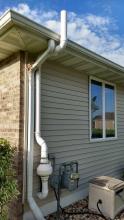Lowering Your Home's Radon Levels
You can lower your home's radon levels
Talk with a contractor who is trained and certified for radon mitigation.
We maintain a list of contractors who are certified for radon mitigation by the American Association of Radon Scientists and Technologists or the National Radon Safety Board.
For independent consulting on radon mitigation, call one of the Wisconsin Radon Information Centers.
Radon 101: How you can reduce radon levels in your home.
Listed below are strategies used to reduce radon levels:
Mitigation
- Radon mitigation systems use sub-slab depressurization to prevent radon from entering your home by drawing the radon from below the house and venting it through a pipe to the outside air above your roof, pictured right.
- Radon mitigation systems can reduce radon to below 2 pCi/L.
- The video above illustrates how sub-slab depressurization works to reduce radon.
Cost: A certified contractor can install a radon mitigation system for around $1,200, although it can range from $800 to $2,000. Sub-slab depressurization is not a do-it-yourself project unless you have considerable contractor skills.
See our list of radon mitigation contractors, and visit "This Old House" to learn more about how mitigation systems are installed.
Sealing
Important note: sealing alone to reduce radon is not recommended. The sealing process, by itself, has shown to not reduce radon very much and it is not very consistent.
- All gaps and openings through basement floors and walls can be sealed with gas-tight materials. The caulk type with the best adhesion to concrete is polyurethane (not silicone).
- Since it can be inexpensive and does make mitigation systems more effective, it is worth a try, but one shouldn't expect it to have a major effect. It might reduce radon levels significantly if the area of openings that are sealed adds up to several square inches. Hairline cracks are not worth sealing.
Construction
Radon-resistant construction can be installed into new homes. Building radon resistance into a new house is cheaper than radon mitigation after construction as the needed building materials are common and the techniques are straightforward. Visit the Environmental Protection Agency's (EPA) webpage Radon-Resistant Construction Basics and Techniques to learn more about radon-resistant construction.
Additional resources
- U.S. EPA Booklet, Building Radon Out: a Step-by-Step Guide on How to Build Radon-Resistant Homes (PDF)
- Pictures, information, prices for radon mitigation supplies; pictures of mitigation system installations
- Pictures, information, prices for radon mitigation supplies
- Pictures, supplies, books and information for mitigation
- Information about radon for families, homeowners, builders and contractors
Radon mitigation system standards
To get the radon as low as reasonably possible, maximize durability, and minimize operating costs for homeowners, regulating states have adopted standards for mitigation systems. The US EPA document, Radon Mitigation Standards (PDF) has been the model. In it, some of the most important features for good mitigation systems are described in Sections 14.2 (vent pipe), 14.3 (fan installation) and 14.5 (sealing).
Experts are available statewide to answer your questions and provide test kits to the general public.
Have questions or need help? Get in touch with a radon expert by calling
1-888-LOW-RADON (1-888-569-7236).


